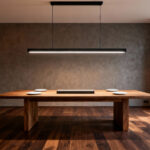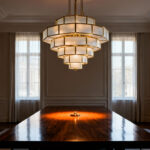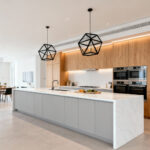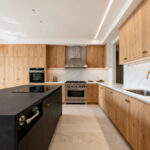Of all the rooms in our home, the bathroom holds a unique psychological weight. It’s where we are at our most vulnerable, where we begin our days and wash them away at night. So, when that space feels chaotic, crowded with half-empty bottles and visual noise, it’s no wonder we start to feel a little chaotic, too.
Imagine a bathroom that’s a deep, cleansing breath. A space of quiet confidence where every surface is clear, the light is soft, and the air just feels different. This isn’t some far-off dream from a design magazine. It’s the power of minimalism, and it’s more than just an aesthetic. It’s a tool for recalibrating your entire day. Let’s walk through the 22 elements that transform a purely functional room into the serene escape you truly deserve.
1. The Power of a Clean Sweep: Master Decluttering First
Let’s be honest: decluttering is the absolute, non-negotiable first step. Without it, you’re just organizing clutter. True minimalism is about elimination, not just arrangement. Think of it as turning down the visual “static” in your room. When your eyes don’t have to process dozens of mismatched objects, your mind can finally, finally relax.

Bathrooms are notorious clutter magnets. That collection of travel-sized shampoos you’ll “definitely use one day,” the expired face masks, the stack of worn-out towels. I once worked with a client who had three different drawers of this stuff. We spent an afternoon just emptying them. The sheer relief on her face as she saw the clean, empty space was palpable. You could feel the weight lift. Start with one drawer. Empty it. Wipe it down. And only put back what you actively use and love. The science backs this up: studies show a direct link between the clutter in our homes and our cortisol (stress hormone) levels. Clearing your counters literally clears your mind.
And just like that, you’ve taken the most important step. Now, let’s give all that beautiful new space a calming backdrop.
2. A Quiet Backdrop: Sticking to a Simple, neutral color palette
Here’s what’s so fascinating about color from a psychological standpoint: our brains perceive neutral, low-contrast palettes as safe and calming. They demand less of us. There’s no hidden complexity to decode, which frees up mental energy. This is the magic of a minimalist color scheme—it creates a clean canvas that lets your mind rest while making the room feel brighter and more expansive.

This doesn’t mean your bathroom has to be sterile white. There’s a whole world of gorgeous, calming neutrals out there:
- Whites: Think beyond builder-basic. Look at creamy, off-whites or whites with a warm, rosy undertone.
- Grays: From soft, misty grays to deeper charcoal tones or my personal favorite, greige (a perfect blend of gray and beige).
- Earthy Tones: Soft, dusty browns, muted sage greens, and sandy hues that feel grounded and organic.
- Black: Used very intentionally as a punctuation mark—a tap, a light fixture—it adds a dose of sophisticated drama.
But a neutral palette doesn’t have to be boring. The secret is texture. Imagine running your hand over cool, matte-finish tiles, then feeling the subtle grain of a light oak vanity, and finally stepping onto a soft, woven cotton rug. This interplay of textures creates a rich, sensory experience that’s deeply sophisticated without shouting for attention.
With our calming color story set, we can start shaping the space itself.
3. The Psychology of Order: Prioritizing Clean, Unbroken Lines
Our brains are hardwired to find and follow patterns. It’s a survival mechanism. When we see clean, unbroken lines, our eyes can move smoothly around the room, which sends a subconscious signal of order, predictability, and safety. That’s why avoiding ornate details and focusing on simple, geometric forms feels so inherently restful. You’re not just designing a bathroom; you’re calming a primal part of the brain.

Achieving this takes a little planning. Think about wall-mounted sinks and toilets that create a single, continuous plane of flooring. Opt for frameless glass shower doors with the bare minimum of hardware. I love seeing cabinets with integrated handles or push-to-open mechanisms—it makes a bank of storage look like a single, quiet wall panel. Even the grout lines matter. Keeping them thin and matching the tile color, or using massive, large-format tiles, minimizes that distracting grid effect.
This idea of stripping things back to their essential form has its roots in movements like Bauhaus, where function and simple geometry were king. It’s a testament to the fact that good design is often about what you leave out.
That same principle of lifting things up and creating visual space leads us to one of the most impactful changes you can make.
4. Lightness of Being: Installing a Sleek Floating Vanity
There’s something almost magical about a floating vanity. By lifting the cabinet off the floor, you expose more flooring and create an immediate, powerful sense of spaciousness. It’s a classic visual trick, but it’s so effective. Your bathroom will instantly feel larger, airier, and less cluttered. It’s a cornerstone of modern minimalism for a reason.

Look for simple, geometric forms in materials that align with your palette:
- Light Woods: Oak, maple, or bamboo bring a dose of natural warmth.
- Matte Finishes: An engineered wood with a matte white or gray finish can almost disappear into the wall.
- Solid Surfaces: Materials like Corian or quartz offer a seamless, durable option.
The key is proportion. A huge, bulky vanity will feel heavy even if it’s floating, so make sure it’s scaled to your room. And here’s an insider tip I love to share with clients: install a soft, warm LED strip light underneath. It enhances the floating effect, creating a beautiful ambient glow at night that’s perfect for a relaxing bath or a late-night trip to the loo.
And speaking of floating…
5. Elevating the Everyday: Considering a Wall-Mounted Toilet
A wall-mounted toilet might seem like a small detail, but it has a huge psychological impact. By concealing the tank inside the wall, you take a clunky, utilitarian object and transform it into a sleek, sculptural form. The visible part is smaller, projecting less into the room and freeing up precious inches of floor space—which in a small bathroom, makes a world of difference.

This is minimalism at its best: taking something functional and making it beautiful and efficient. The uninterrupted floor underneath is not only easier to clean (a huge functional win), but it also enhances that feeling of spaciousness we’re aiming for. It just looks and feels cleaner.
Now, this is where it gets tricky, and it’s important to be honest about the process. Yes, they cost more upfront. And yes, the installation is more complex because it involves an in-wall carrier system. Repairs can be more involved, though modern systems have access panels that make it much easier than it used to be. For a true minimalist project, though, the aesthetic and space-saving rewards are often well worth the investment.
The goal is to eliminate as many visual breaks and seams as possible, which brings us to the countertop.
6. The Beauty of Seamlessness: Choosing an Integrated Sink
An integrated sink—where the basin is molded from the same continuous piece of material as the countertop—is the epitome of minimalist elegance. There are no seams, no rims, no awkward crevices where gunk can build up. It’s one smooth, uninterrupted surface.

What really gets me is the dual benefit here. Aesthetically, it’s incredibly pleasing. The eye just glides right over it, reinforcing that sense of calm and flow. But functionally, it’s a dream. Cleaning is as simple as wiping the counter straight into the sink. No more grime collecting around the edge of a drop-in basin. This perfect marriage of form and function is what minimalism is all about.
You can find them in all sorts of great materials:
- Solid Surface (like Corian): My personal go-to for its seamless look and reparability.
- Quartz: Incredibly durable and stain-resistant.
- Concrete: For a unique, slightly industrial look that can be customized.
- Glass: A very modern, sleek choice.
This is a trend that reflects our larger cultural desire for simplified, easier living. An integrated sink is a small luxury that makes a daily task just a little bit more beautiful and effortless.
From here, we can zoom out and apply this “less is more” philosophy to all the little details.
7. Less is More: Going Minimal on Hardware and Fixtures
Think of hardware and fixtures as the jewelry of your bathroom. In a minimalist design, you don’t want loud, chunky, costume jewelry; you want a single, elegant, understated piece. Every handle, knob, faucet, and towel bar adds “visual weight” to a room. By choosing streamlined forms and reducing the sheer number of fixtures, you make the entire space feel quieter and more intentional.

The finish is just as important as the form. Stick to one cohesive finish throughout the space to avoid visual clutter. Some excellent choices are:
- Matte Black: Bold, modern, and graphic.
- Brushed Nickel or Brass: Softer and warmer than polished finishes.
- Polished Chrome: A timeless classic that reflects light beautifully.
Consistency is your best friend here. It helps unify the space and reduces the number of visual “decisions” your brain has to make when taking in the room. And don’t be afraid to think outside the box. Instead of a traditional towel bar, could you use a few simple, beautiful hooks? Instead of pulls on every drawer, could you use push-to-open latches? Every element you can simplify or remove contributes to that overall sense of peace.
Of course, once you’ve simplified the visible elements, you have to figure out where to put everything.
8. The Art of Disappearing: Mastering Hidden Storage
Visible clutter is the number one enemy of serenity. Let me say that again. Visible clutter is the enemy. It constantly signals to our brains that there are tasks to be done, things to be put away. Hidden storage is your secret weapon. It’s how you get that impossibly clean, spa-like look while still having a place for your contact solution and that giant bottle of conditioner.

Think of it as creating a calm “backdrop” for your life, instead of letting your stuff be the main event. Here are some of my favorite clever spots for hidden storage:
- Recessed Medicine Cabinets: Mirrored cabinets set flush into the wall are a classic for a reason.
- Integrated Wall Niches with Doors: Perfect for inside the shower.
- Tall, Slim Cabinets: A floor-to-ceiling cabinet painted the same color as the wall can seem to disappear.
- Under-Sink Drawers: Forget the deep, dark cavern. Get a vanity with well-designed drawers and internal organizers.
To really nail the look, opt for handle-free, push-to-open doors and drawers. The result is a seamless surface that completely conceals the “stuff” of life, leaving you with a space that feels calm, orderly, and always ready for you to relax in. This is probably the hardest discipline of minimalism to maintain, but it pays the biggest dividends in daily calm.
Now that the clutter is handled, we can literally put our design in the best light.
9. More Than a Bulb: Illuminating with Intention
In a minimalist room, lighting isn’t just a utility—it’s a primary design element. When you’ve stripped away all the unnecessary decoration, light becomes the thing that sculpts the space, creates the mood, and highlights the beautiful textures you’ve chosen. A bad lighting plan can make even the most beautiful minimalist bathroom feel like a cold, sterile box.

A truly well-lit space isn’t about one bright overhead light. It’s about building layers of light to suit different needs and moods:
- Ambient Lighting: This is your general, overall illumination. Think recessed ceiling lights or a simple, elegant ceiling fixture.
- Task Lighting: This is your bright, focused light for things like applying makeup or shaving. Sconces on either side of the mirror are far better than one light above, as they eliminate shadows on your face.
- Accent Lighting: This is the fun part! It’s the soft glow from under your floating vanity or the light highlighting a niche in the shower. It adds depth and drama.
And here’s the most common mistake I see people make: they forget dimmers! Put everything on a dimmer. This is non-negotiable. It allows you to have bright, energizing light in the morning and a soft, warm, relaxing glow for an evening bath. It gives you complete control over the room’s energy, which is a powerful tool for well-being.
That sense of seamlessness and calm can extend right down to the floor.
10. The Disappearing Act: Selecting Large Format Tiles
Grout lines are, essentially, a grid. And our brains have to process that grid. The more lines there are, the busier the surface looks and feels. By using large format tiles—anything from 12×24 inches up to massive 24×48-inch slabs—you dramatically reduce the number of grout lines. The effect is a cleaner, more continuous surface that makes the entire bathroom feel larger and more serene.

It’s a subtle change with a huge psychological payoff. Your floor or walls become a quiet, monolithic surface rather than a busy pattern. It’s a prime example of minimalism’s emphasis on simplicity and practicality, because fewer grout lines also mean less to scrub and a lower chance of mildew. A win-win.
A few things to keep in mind: these larger tiles are heavier and require a perfectly flat surface, so professional installation is an absolute must to avoid uneven edges (called “lippage”). And for the grout you do have, I always recommend choosing a color that’s as close as possible to the tile color. This helps the lines recede even further, creating that coveted seamless look.
And we can apply that same seamless logic to the shower.
11. Erasing Boundaries: Designing a Frameless Walk-In Shower
A frameless, walk-in shower is one of the hallmarks of a contemporary minimalist bathroom. By eliminating the visual barrier of a bulky frame, a metal track, or even a shower curtain, you create a seamless transition between the shower and the rest of the bathroom. It’s an instant space-expander.

But beyond just making the room feel bigger, it taps into a feeling of openness and freedom. There’s no claustrophobic box to step into. The whole design feels more honest and integrated.
Planning is everything here. You absolutely must get the drainage right. This means ensuring the shower floor is properly sloped toward a well-placed drain (a sleek linear drain is a fantastic minimalist choice). The glass itself is typically 3/8-inch or 1/2-inch tempered safety glass for a sturdy, high-quality feel. For an extra-clear look, ask for low-iron glass, which has less of the green tint you see in standard glass. And don’t forget to include a recessed niche inside the shower for your shampoo and soap—keeping bottles off the floor is key!
That openness can sometimes feel a bit cold. The perfect antidote? Introducing some natural, organic warmth.
12. A Touch of Nature: Incorporating Natural Materials for Warmth
Here’s where minimalism gets wonderfully warm and soulful. Without the warmth and texture of natural materials, a minimalist space can risk feeling cold, stark, and impersonal. Introducing wood, stone, and natural fibers taps into a deep, primal part of our psychology called “biophilia”—our innate human need to connect with nature. It’s grounding, calming, and it makes a space feel alive.

These materials are your best friends for adding character without adding clutter:
- Wood: A teak shower bench, a white oak vanity, or even just some beautiful bamboo accessories.
- Stone: A marble or slate countertop, or maybe travertine floor tiles. The veining and imperfections are what make it beautiful.
- Natural Fibers: A simple linen shower curtain (if you’re not doing a walk-in), soft cotton towels, or a jute rug.
- Plants: A single, well-chosen plant like a snake plant or a fern in a simple pot can bring life and air-purifying qualities to the space.
The trick is moderation. You don’t need all of them. Choose one or two to be the star. A beautiful wooden vanity against a backdrop of simple tile creates a stunning focal point that feels both modern and timeless. Just be sure any wood used in a wet environment is properly sealed!
This leads us to a slightly controversial idea in the world of pure minimalism.
13. The Power of One: Allowing a Single Statement Piece to Shine
At first, I resisted this idea. I thought pure minimalism meant nothing stood out. But then I realized that without a focal point, a room can feel a little lost and, frankly, boring. A single, incredible statement piece doesn’t violate the principles of minimalism; it elevates them. It proves that the space is intentional, not just empty. It’s your chance to inject personality.

A statement piece gives your eye a place to land and rest. It becomes the anchor around which all the quiet, simple elements revolve. What could it be?
- A stunning, sculptural freestanding tub.
- A vintage mirror with a beautiful, ornate frame in an otherwise modern space.
- A single piece of vibrant, oversized art.
- A truly spectacular light fixture.
Here’s the rule: It must be the only one. Everything else has to remain simple and serve a supporting role. You establish the clean, uncluttered foundation first, and then you introduce your one moment of “wow.” It’s a move that requires confidence, but it’s what separates a generic minimalist room from one that truly tells a story.
Once your design is in place, maintaining that feeling comes down to daily habits.
14. A Daily Ritual: Keeping Countertops and Surfaces Completely Clear
This is more than a cleaning tip; it’s a mindfulness practice. A cluttered countertop is a constant to-do list for your brain. Toothpaste, hairbrush, lotion, makeup—each one is a small, visual demand. By making a habit of keeping your countertops completely clear, you are giving yourself the gift of a restful visual field every time you enter the room.

So where does all that daily stuff go? Back to our friend, hidden storage. Toothbrushes in the medicine cabinet. Makeup in a drawer organizer. Hair dryer in a deep drawer. Create a system where everything has a home, and the “home” is out of sight.
If there are one or two items you use constantly and absolutely must have out, contain them. Place them on a small, beautiful tray made of wood, stone, or ceramic. This simple act of containment groups them into a single visual element, which is far more calming than having them scattered about. It’s a small change in habit that makes a massive difference in how calm and spa-like your bathroom feels on a daily basis.
This principle of visual simplicity extends to the fixtures we touch every day.
15. The Feel of Quality: Picking Simple, Streamlined Faucets and Showerheads
Faucets and showerheads are some of the most tactile elements in your bathroom. You interact with them every single day. In a minimalist design, their form should be as simple and functional as possible. Ornate, fussy designs create visual noise and can disrupt the clean lines you’ve worked so hard to establish.

Look for fixtures with clean, geometric shapes—simple cylinders, graceful arcs, solid rectangles. A single-handle faucet is often more visually simple than one with two separate handles. A wall-mounted faucet is an even more advanced move, as it keeps the countertop completely clear. And when you choose a simple form, the quality of the material and finish becomes even more important. A well-made fixture in matte black or brushed brass has a heft and smoothness that just feels good to use.
This isn’t about just how it looks; it’s about how it feels. It’s those tiny moments of quality in your daily routine—the smooth turn of a well-made handle, the solid feel of the metal—that reinforce a sense of well-being and care.
And our most-used tactile item? That needs a home, too.
16. Out of Sight: Implementing Smart, Concealed Towel Storage
A stack of colorful towels, no matter how neatly folded, can be a major source of visual clutter. And let’s be real, how often do they stay neatly folded? Implementing smart, concealed storage for your towels is a game-changer for maintaining that serene, uncluttered aesthetic. By hiding them away, you allow the beautiful architectural elements of your bathroom to take center stage.

What does this look like in practice?
- Deep drawers within your vanity, designed specifically for towels.
- A floor-to-ceiling cabinet with push-to-open doors that blends in with the wall.
- A storage bench with a lid where you can toss towels.
- Recessed niches near the shower for the towels currently in use.
For the towels you need to hang to dry, opt for simple hooks instead of a long, bulky towel bar. Hooks have a smaller visual footprint and feel more casual and effortless. Hiding away the bulk of your towels removes the visual reminder of a chore (laundry!) and contributes to a space that feels genuinely restful.
With the big functional items handled, let’s talk about the final layer.
17. The Art of the Edit: Limiting Decor to Absolute Essentials
In a minimalist space, we don’t “decorate”; we “curate.” Every single object must have a reason for being there. It should be either genuinely useful, exceptionally beautiful, or—ideally—both. This is about ruthless editing. It forces you to be incredibly intentional.

What counts as essential decor? It might be:
- A beautiful soap dispenser made of stone or ceramic.
- A single plant that brings a touch of life.
- One beautiful, framed piece of art (not a gallery wall).
- A very special candle in a simple vessel.
Before adding anything, live in the space for a bit. See what you actually need. Then, when you do add an object, make sure it’s one you absolutely love. The minimalist art movement of the 1960s was all about stripping away emotion and decoration. I think in home design, we can take that principle and add a little soul back in. The rule is simple: if an item doesn’t serve a function or bring you genuine joy, it doesn’t belong in your sanctuary.
Part of that sanctuary feeling is about more than just what you can see.
18. Take a Deep Breath: Ensuring Excellent Ventilation and Airflow
This might sound like a purely practical point, but it’s deeply tied to the psychology of a space. A damp, stuffy bathroom feels unhealthy. Our primal brains are on high alert for mold and mildew. In a minimalist bathroom with its clean surfaces, any sign of condensation or moisture becomes immediately obvious and detracts from that pristine feeling. Excellent ventilation is not a luxury; it’s essential for preserving both the aesthetic and the health of your sanctuary.

At a minimum, you need a high-quality, quiet exhaust fan. Look at the CFM rating (Cubic Feet per Minute) to ensure it’s powerful enough for your room’s size (the rule of thumb is 1 CFM per square foot of floor space). And pay attention to the sone rating—a lower number means a quieter fan, which is key for a tranquil space.
A better option? A fan with a humidity sensor that turns on automatically when it detects moisture and shuts off when the air is clear. It’s the ultimate “set it and forget it” feature, perfectly aligned with the effortless functionality of minimalism. Fresh, clean air is a fundamental component of a space that feels truly rejuvenating.
This focus on what works brings us to the core philosophy of the entire design.
19. Function First, Always: The Unbreakable Rule
If you take only one thing away from all of this, let it be this: Minimalism is functionality, personified. Every single design choice must be rooted in purpose. A room that is beautiful but doesn’t work for your life is a failed design. Before you choose any item, from the tub to the toothbrush holder, you have to ask yourself a series of tough questions.

- How will I actually use this? Daily? Weekly?
- Does this solve a real problem for me?
- Is there a simpler, more efficient way to accomplish this task?
- Does it improve how the bathroom flows and feels, or does it get in the way?
I had a client who was desperate for a huge, freestanding soaking tub. But she lived alone, had a tiny bathroom, and only took quick showers. The tub was a beautiful idea, but it wasn’t functional for her life. We opted for a spacious, luxurious walk-in shower instead, and she was so much happier. Be ruthlessly honest with yourself. Design the bathroom you will actually use, not the one you think you’re supposed to want.
This commitment to function leads directly to our next point.
20. The Long Game: Investing in Quality Over Quantity
Minimalism isn’t about being cheap; it’s about being intentional. And part of that intention is choosing to own fewer, better things. In a bathroom, where items are subjected to daily use, moisture, and wear, investing in quality is paramount. A cheap faucet will start to corrode. A flimsy vanity will warp in the humidity. Poorly made items quickly degrade, undermining the very sense of calm and order you’ve tried to create.

I always tell my clients, “Quality is what you remember long after you’ve forgotten the price.” This is especially true in a space you use multiple times a day. Investing in quality is an act of self-respect. It sends a subconscious signal that your daily rituals are worthy of beautiful, durable, well-functioning tools.
Where should you focus your investment?
- Fixtures: A high-quality toilet and well-made faucets/showerheads are worth every penny.
- Surfaces: Durable countertops and tiles that can stand up to moisture and cleaning.
- Cabinetry: Solid wood or high-quality engineered wood that won’t be affected by humidity.
These high-quality pieces form the backbone of your design, ensuring your sanctuary not only looks beautiful today but functions beautifully for years to come.
Next, a simple trick with an almost magical effect.
21. The Illusionist’s Trick: Using Mirrors to Enhance Light and Space
Mirrors are the secret weapon of any small or dark room. They are pure magic. By reflecting light and the room itself, they create a powerful optical illusion, making a space feel dramatically larger, brighter, and more open. In a minimalist bathroom, where there are fewer objects and cleaner lines, this effect is amplified. The clean lines are multiplied, the light is bounced around, and the whole room comes alive.

The bigger, the better.
- A large, simple, frameless mirror that spans the entire wall above your vanity is a showstopper.
- Even a simple round mirror can soften all the hard, geometric lines of a minimalist design.
- For extra credit, a backlit mirror provides a soft, ambient glow that eliminates the need for some other light fixtures.
Placement is key. The classic spot is above the vanity, but consider placing a mirror opposite a window. It will essentially act like a second window, doubling the amount of natural light—and light, as we know, is a nutrient for our well-being. This simple addition can fundamentally change the energy of your entire bathroom.
Finally, we arrive at the most challenging—and potentially rewarding—element of all.
22. The Final Boss: Curating Open Shelving (If You Dare)
Alright, stay with me here. This is the advanced move. Open shelving in a minimalist bathroom is a high-stakes game. Done right, it adds a touch of personality, warmth, and curated beauty. Done wrong, it’s a fast track to cluttered chaos that undermines everything you’ve worked for. It demands constant discipline.

If you’re up for the challenge, here are the rules of engagement:
- Less is Everything: Negative space is your best friend. A shelf should be at least 50% empty.
- Beauty + Function: Every single item on that shelf must be both useful and beautiful. Think rolled-up white towels, a gorgeous glass bottle of bath oil, a ceramic cup holding toothbrushes, a small plant.
- Cohesive Palette: Stick to the color palette of your bathroom. Use matching containers or decant products into beautiful, simple bottles to conceal ugly branding.
- Ruthless Editing: You must be willing to dust frequently and constantly edit what lives there.
Honestly? For most people, I recommend sticking with hidden storage. But if you have a collection of beautiful objects and the discipline to maintain it, a single floating shelf made of natural wood or sleek metal can be a stunning final touch—an intentional moment of curated beauty amidst the calm.
Your Personal Retreat Awaits
Creating a minimalist bathroom is so much more than a design project. It’s a choice to create an environment that actively supports your peace of mind. By decluttering with intention, choosing a calming palette, focusing on clean lines, and investing in quiet quality, you are turning a utilitarian space into a personal sanctuary.
The journey is about stripping away the non-essential to let what truly matters—calm, function, and simple beauty—shine through. It’s about building a space that doesn’t demand anything from you, but instead gives back. A space that helps you start your day with clarity and end it with tranquility. It’s your personal retreat from the chaos of the world, right in your own home.






